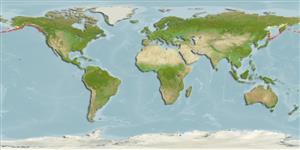Environment: milieu / climate zone / depth range / distribution range
Ecology
Marine; demersal; depth range 0 - 20 m (Ref. 50610). Temperate
Eastern Pacific: Bering Sea coast of Alaska to the western Aleutian Islands and Oregon, USA.
Size / Weight / Age
Maturity: Lm ? range ? - ? cm
Max length : 12.7 cm TL male/unsexed; (Ref. 50520)
Occurs in tide pools and other intertidal areas (Ref. 2850).
Life cycle and mating behavior
Maturity | Reproduction | Spawning | Eggs | Fecundity | Larvae
Chernova, N.V., 2008. Systematics and phylogeny of fish of the genus Liparis (Liparidae, Scorpaeniformes). J. Ichthyol. 48(10):831-852. (Ref. 79981)
IUCN Red List Status (Ref. 130435: Version 2024-2)
Threat to humans
Harmless
Human uses
Fisheries: of no interest
Tools
Special reports
Download XML
Internet sources
Estimates based on models
Preferred temperature (Ref.
123201): 4.5 - 10.4, mean 6.7 °C (based on 567 cells).
Phylogenetic diversity index (Ref.
82804): PD
50 = 0.5000 [Uniqueness, from 0.5 = low to 2.0 = high].
Bayesian length-weight: a=0.00525 (0.00237 - 0.01161), b=3.15 (2.96 - 3.34), in cm total length, based on LWR estimates for this (Sub)family-body shape (Ref.
93245).
Trophic level (Ref.
69278): 3.4 ±0.51 se; based on food items.
Resilience (Ref.
120179): High, minimum population doubling time less than 15 months (Preliminary K or Fecundity.).
Fishing Vulnerability (Ref.
59153): Low vulnerability (10 of 100).
